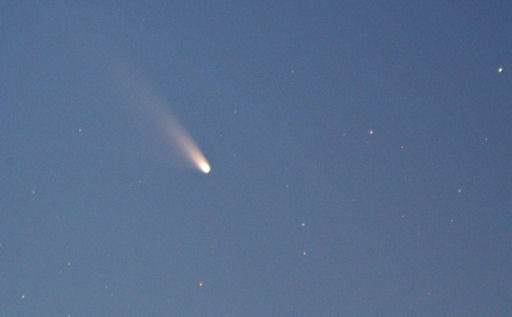They came from outer space--and you can have one! Genuine meteorites are now on sale in the Space Weather Store. | | |
NEW RADIATION BELT DISCOVERED: NASA's twin Van Allen Probes, launched just last August, have revealed a previously unknown third radiation belt around Earth. Get the full story from Science@NASA.
GEOMAGNETIC STORM: A high-speed solar wind stream is buffeting Earth's magnetic field and sparking bright auroras around the Arctic Circle. Frank Olsen sends this picture from Sortland, Norway:

"The weather here in Vesterålen has been terrible for more than a week," says Olsen. "I was so glad the clouds parted so we could catch the auroras at 1:30 am local time on March the 1st."
More auroras are in the offing. NOAA forecasters estimate a 45% chance of polar geomagnetic storms on March 2-3 as the solar wind continues to blow. Aurora alerts: text, voice.
Realtime Aurora Photo Gallery
COMET PAN-STARRS UPDATE: Comet Pan-STARRS, now visible in the southern hemispherre, is brightening as it plunges toward the sun, Amateur astronomer Ian Cooper sends this report from Glen Oroua, New Zealand: "Despite lingering evening twilight and the glare from a nearly full Moon, Comet Pan-STARRS is a 3rd-magnitude object with a fine orange dust tail visible in both binoculars and small telescopes." A 30-second exposure with his Canon 450D digital camera easily revealed the comet in the not-quite-dark sky:

In early March, the comet will pass about 100 million miles from Earth as it briefly dips inside the orbit of Mercury. At that time it is expected to brighten another three-fold to 2nd magnitude, about as bright as the stars in the Big Dipper. Whether Pan-STARRS will actually be visible to the naked eye through the glow of the nearby sun remains to be seen; this NASA video explores the possibilities. Whatever happens, observers in the northern hemisphere will have a front row seat as the comet crosses the celestial equator on March 12th. Stay tuned!
More about Comet Pan-STARRS: 3D orbit, ephemeris, light curves.
Realtime Comet Photo Gallery
Realtime Space Weather Photo Gallery
Realtime Noctilucent Cloud Photo Gallery
[previous years: 2003, 2004, 2005, 2006, 2007, 2008, 2009, 2011]
Potentially Hazardous Asteroids (
PHAs) are space rocks larger than approximately 100m that can come closer to Earth than 0.05 AU. None of the known PHAs is on a collision course with our planet, although astronomers are finding
new ones all the time.
On March 1, 2013 there were 1381 potentially hazardous asteroids.
Notes: LD means "Lunar Distance." 1 LD = 384,401 km, the distance between Earth and the Moon. 1 LD also equals 0.00256 AU. MAG is the visual magnitude of the asteroid on the date of closest approach. | | The official U.S. government space weather bureau |
| | The first place to look for information about sundogs, pillars, rainbows and related phenomena. |
| | Researchers call it a "Hubble for the sun." SDO is the most advanced solar observatory ever. |
| | 3D views of the sun from NASA's Solar and Terrestrial Relations Observatory |
| | Realtime and archival images of the Sun from SOHO. |
| | from the NOAA Space Environment Center |
| | the underlying science of space weather |

